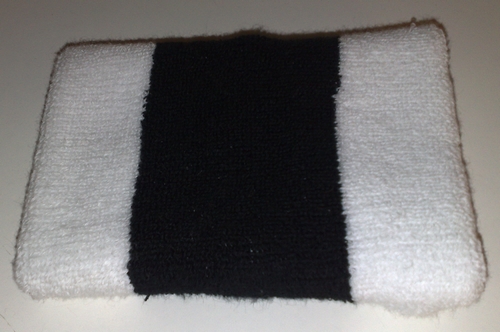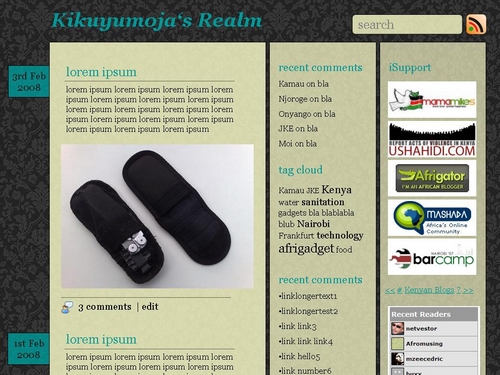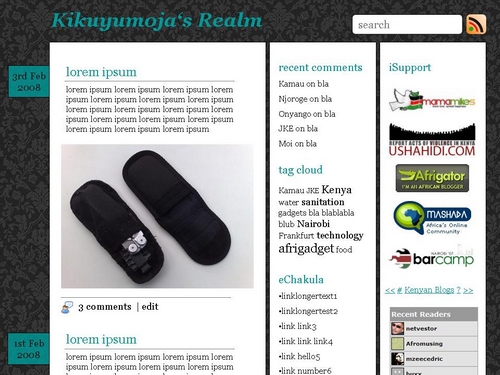What’s this?

Maybe it’s just me and my way of looking for the core information on websites that goes beyond the usual marketing blabla – but could it be true that there have been various Kenyan websites coming up lately that actually do NOT have any serious content? Or at least not much more than what the webdesigner had initially put up online and has since been waiting for a content update (to be published online)?
Where are those content editors out there? Do I smell a job opportunity out there for young folks? Ppl who will help companies and organisations to edit their message for online publishing?
Am asking because I sometimes come across such websites where I think: aah, ok, these guys just had some extra funds and wanted to be online for no apparent reason and actually haven’t thought about what to put online. Makes me think of Ayittey and the leaking bowl…
Disclaimer: Not a real post for now, but I’ll post it anyways…just a lose collection of thoughts (so that I don’t have to keep on repeating myself on this topic).
Obed, my colleague from Zambia, founded an NGO some years ago. Today he told me that his NGO actually requires a website.
At this point, most people will just hire someone who takes care of this and prolly lose some US$ down the road. Also, once the website is up and running, it doesn’t really imply that things are perfect. What he’ll then need is someone who does the site maintenance (admin) and who prepares all online content (content editor).
In order to get your NGO online, you will need:
a) a domain name
The shorter, the better; maybe best .org for an NGO; domain names are relatively cheap; if you have a CreditCard (!) or a PayPal account payments may be easier & cheaper (this CC thing really IS an issue!)
b) webhosting
1GB webspace, 1MySQL database, 1 FTP account, etc. = simple packages will do for most requirements; webhosting often includes one *free* .com domain name; there are some free webhosting sites that do / do not display advertisment (which you may not be able to control); user/server ratio often isn’t visible (= how many users/domain packages actually share one server? = perfomance index), service hotline?; backup = you are responsible for your own backups, especially with cheap webhosting packages; depending on your financial situation, you can manage to obtain all of this for *free* or pay a monthly fee. There are hundreds of providers/resellers out there + websites that give an overview of what customers are reporting on the actual quality of the provided service.
c) the right *software*
WordPress :-)
WordPress.org if you want to install a WordPress blog on your server and customize it, or WordPress.com if those standard templates on WordPress.com are ok with you. WordPress, a blog “software”, instead of an advanced Content Management System (CMS) because it will be easier to manage & often just does the job. WordPress.org comes with a HUGE community and many free templates that can be further modified.
Any other blog software will certainly also do, however, it just helps to illustrate the fact that this publishing platform is sufficient for most websites (see d)).
d) an idea of what to put online
Most crucial point. Who will be in charge of the online content? What do you want to put online? How many static pages? What kind of pictures? The person in charge of online content will probably also need to rescale pictures and trim them for online usage (lower dpi resolution), no need for 2-3 MB pictures that directly come from a digital camera. Apply a licence to your works (=> CreativeCommons) so that ppl will know how do deal with your (!) online content. Create a document and define what you want to publish online and how you want to interlink it – in short, create a concept. This will help everyone involved to see what the target is.
etc.
Bottom-line: getting YOUR page and YOUR mission online isn’t a matter of experts anymore. What you will need to figure out is how much money you want to spend on this, how the site should appear (layout) and who will be in charge.
I am mentioning all these *basic* facts (to most readers – I assume that most of you are running your own blog?) because it’s just SOOOOO often that you see a brother from somewhere who’s doing a wonderful job within his organisation, but is totally overwhelmed by the (relatively simple) job of creating a decent website that draws a clean line between horrible MS-Frontpage or MS-Office documents (converted into HTML/XML) and a smooth little website based on a sweet WordPress *simple-CMS* package.
Also, you’re not alone on this. Pls feel free to visit Kabissa.org to connect with others and discuss on how to promote your works online.
What’s eyeOS?
EyeOS is virtual desktop / operating system accessible through a browser. Or as they describe it on their website:
eyeOS is a new kind of Operating System, where everything resides on a web browser. With eyeOS, you will have your desktop, applications and files always with you, from your home, your college, your office or your neightboor’s house. Just open a web browser, connect to your eyeOS System and access your personal desktop and all your stuff just like you left it last time.
[youtube Zt35LLcMlcM nolink]
So I’ve downloaded their latest release and installed it on my webspace. Note: I am still on 1&1 (1und1.de / 1and1.com) due to historic reasons (urgently need to switch to a cheaper host though – any recommendations that really work & are reliable? Uptime on 1&1 has been great in the past but they are just crazy about mySQL dbs and other extras. Automatization / user admin panel is still very nice on their system so any other cheaper service would need to offer a good admin panel as well. thx!) and eyeOS requires php 5 in order to run. 1&1 offers both php 4 and 5, but 4 is the default setting. In order to use php 5 on your 1&1 server, you’ll need to rename all files from .php to .php5 and likewise all links / references / calls to other php files within the install.php & index.php. Did that and it just works fine:

You can test it for yourself on eyeOS.info and I recommend to set your browser to fullscreen view (F11?) in order to fully enjoy the desktop.
So WHY is this interesting?
Imho, eyeOS is a very interesting alternative to….to what? To a virtual machine in the network via VMWARE or a remote VNC connection? Maybe. I think it rather indicates that the future is all about “being connected” = networked computers and that data will then be stored on a main server somewhere, accessible from anywhere in the world. Storing devices such as CDs, DVDs, USB flash disk are the best indicator to see how everything quickly changes from long-time archives to fast-and-forget memory. Following this line of thinking, the question of illegal downloades could one day just be solved as all multimedia files could remain on a central repository and usage (you dont need to physically”posses” data on your hard drive – you just want to use it, right?) would be paid for. Sure there would be ways to crack or bypass that but that’s just another question.
As for now, as broadband / fast inet connection isn’t available everywhere in the world, I tend to regard this only from a local area network perspective. Has this already been implemented at a local university? => Skunkworks Kenya / Kenyatta University?
I like eyeOS because it doesn’t require much to work. It’s simple, it’s efficient, it wins.
Ppl use Wikipedia to access encyclopedic knowledge on a certain topic.
Ppl use Google for a broader search on a topic.
Ppl use Del.icio.us to receive selected search results that have been pre-selected by human users.
Ppl use Amazon for buying books online.
Ppl use eBay to find a used spare part or other interesting items available for purchase.
The other day I saved this link to my delicious account which provides many interesting DIY manuals on various topics. You know how many websites there are that provide DIY manuals or user guides? Many! – BUT! you’ll never find them because they aren’t as SEXY as Wikipedia or Google or Delicious or Amazon. “Sexy”, as in “known + popular + easy to use”.
WHAT WE NEED to have is a 1stop-resource-online with manuals on each and every topic, all of them attributed with a CreativeCommons licence for transparency reasons and a tagged system.
THE BEST WAY to achieve this would be to ask ALL providers of DIY manuals online to enter their publications one by one into a social bookmarking system online (or a dedicated website on this topic) and tag them with appropriate keywords for further reference.
It would make things so much easier.
Besides, having them in a social bookmarking website, we wouldn’t need to create one huge server with bandwidth capacity, but instead everything could remain where it is right now… also, i am just talking about DO IT YOURSELF manuals here, not the usual corporate *soft* blabla like “discussion papers”, “***** framework”, “what ought to be done”-papers and other “please consider the environment before printing this paper”-documents that are just justifying the PhD of some authors but don’t change anything to the better for those who are willing to change the situation they are in and could actually make use of the aggregated knowledge as found in DIY manuals.
Me thinks: most organizations just don’t do this because a) they don’t know about social bookmarking websites, b) there’s no policy on this, c) they are consequently not paid for this extra work and d)? there’s a certain aim to stick to their publications = products = proof of their work = income generator for the years to come.
As mentioned earlier, I am currently searching for a new template for this blog. Don’t get me wrong – the current Sirius theme is great and offers lots of comfort and whitespace, but it’s from 2006 (dev unfortunately stopped since then which is such a pity!) and so I thought about going for a new one. Simple as that.
Most templates aren’t that 100% perfect though and/or still require lots of tweaking. So what IF i come up with my own layout? Instead of stealing something from here or there and mixing it all up, let me just do some try&error sketching and present it here as a raw draft:

Actually, I like this grey wallpaper, also have it on my desktop. Wallpapers are a bit too 1990s, but so what. Used to have no image on my desktop to save RAM + keep it fast & clean, but nowadays I just dont care. So, the basic idea was to create something around this wallpaper that doesnt look too ..ahh…strange ? :-)
Next task was to see which colour may fit. I need lots of whitespace due to my inability to include transparent backgrounds to the smaller banners. Whitespace looks nice. Lakini here, there’s no whitespace. Only transparent ebony(-white) supposed-to-be-slightly-rounded boxes that have a yellow-ish touch to it. White on ebony/yellow – does that work?
Then the font colours. I somehow like that green/turquoise. Sijui why. Maybe because of my Kikoi banner on the Sirius theme.
As for fonts: GEORGIA! Lovely font.
Icons by FamFam and 69mb (thx!).
1 content bar, 2 sidebars. 1st sidebar for blog related links (recent comments, links, meta, etc.), 2nd sidebar for external promotions / google adsense etc.
Thought about giving them some transparency – the most important one (= content bar) with the lowest transparency and so on (as pictured).
Overall width ~ 900 px, should display @ 1024×768. Oh, and content bar should be 505 – 530 px for all my 500px images + margins.
Everything else is work in progress. Before I continue, I would like to hear/read your HONEST opinion on this. Does this look OK or just horrible? Remember, I am the guy who does these things, so I may be a bit strange sometimes…
Any feedback is appreciated! :-)
Oh, and with white layers:

I am currently looking for a suitable Content Management System (CMS) for a website which is able to create an offline version of all pages to be run directly from a CD or DVD.
The only working solution I can currently think of is something where you’d have a (virtual) local server running which then provides the dynamics for an attached database, but I was hoping that maybe someone out there knows a better solution, maybe something where a script creates static versions of each page and then copies them into a folder (~ cron job every night).
Joomla? Drupal? Typo3? Anyone?
Any help is appreciated! Thx.
Hier jetzt mal etwas ganz anderes, nämlich eine *Wie-geht-das?*-Anleitung für meine Mum und andere (ältere) Freunde, die neben dem Internet immer noch gerne in der Papierausgabe ihrer Lieblingszeitung stöbern.
Eines auch gleich vorweg: es gibt im Internet viele Möglichkeiten, um an Informationen heranzukommen. Diese Anleitung ist nicht all-umfassend und sicherlich auch nicht der beste Weg, aber dafür meiner Meinung nach relativ zukunftssicher…